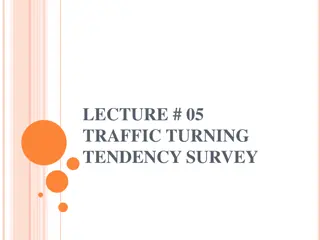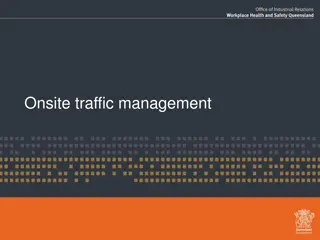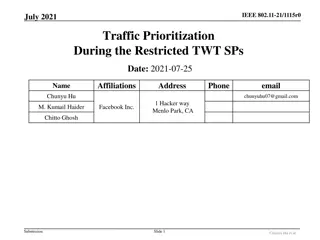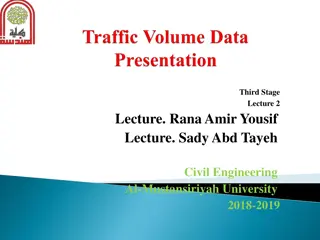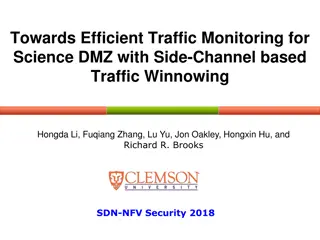Understanding Traffic Engineering Studies in Civil Engineering
Traffic engineering is a crucial aspect of transportation engineering that encompasses planning, design, and operation of roads, streets, and highways. It involves analyzing traffic volume, speed studies, parking patterns, traffic flow characteristics, accident studies, and more. Traffic volume studies aim to determine vehicle movements and trends, helping in identifying critical flow periods and analyzing traffic volume data. Manual and automatic methods are utilized for conducting traffic volume counts based on the study objectives.
Download Presentation

Please find below an Image/Link to download the presentation.
The content on the website is provided AS IS for your information and personal use only. It may not be sold, licensed, or shared on other websites without obtaining consent from the author. Download presentation by click this link. If you encounter any issues during the download, it is possible that the publisher has removed the file from their server.
E N D
Presentation Transcript
Third Stage Lecture 1 Lecture. Rana Amir Yousif Lecture. SadyAbd Tayeh Civil Engineering Al-Mustansiriyah University 2018-2019
Traffic Engineering:- That phase of transportation engineering which deals with the planning , geometric design and traffic operations of roads, streets and highway, their networks, terminals and relationship with other modes of transportation. Traffic: refers to the actual movement of vehicles or pedestrians on a facility. Scope of Traffic Engineering: Traffic engineering studies conducted to obtain data on transportation and traffic trends for entire regions and on traffic conditions at specific locations.
Vehicular and human factors. Traffic volume studies. Speed Studies: Spot speed studies. Speed and delay study. Parking studies. Traffic flow characteristics. Traffic capacity study. Accident studies. 1. 2. 3.
Traffic volume- is defined as the number of vehicles (or persons) that pass a point on a transportation facility during a specified time period, which is usually one hour. In traffic engineering studies there are many volumes such as daily volume, hourly volume, peak hour volume. In addition volumes of a day or an hour can vary greatly, depending on the different day of the week or different time period of a day. Benefits: Traffic volume studies are conducted to determine the number, movements, and classifications of roadway vehicles at a given location.
The traffic volume data can identify critical flow time periods, determine the influence of large vehicles or pedestrians on vehicular traffic flow, or document traffic volume trends. The length of the sampling period depends on the type of count being taken and the intended use of the data recorded. Example: An intersection count may be conducted during the peak flow period. If so, manual count with 15-minutes intervals could be used to obtain the traffic volume data.
Two methods are available for conducting traffic volume counts: (1) manual and (2) automatic. Manual counts are typically used to gather data for determination of vehicle movements, direction movements, or vehicle occupancy. Automatic counts are typically used to gather data for determination of vehicle hourly patterns, daily or seasonal variations and growth trends, or annual traffic estimates. classification, travel, turning pedestrian of
The selection of study method is determined using the count period. The count period should be the time of day, day of month, and month of year for the study area. Count periods may range from 5 minutes to 1 year. Typical count periods are 15 minutes or 2 hours for peak periods, 4 hours for morning and afternoon peaks, 6 hours for midday, and 12 hours for daytime periods. For example, if we are conducting a 2-hour peak period count, eight 15-minute counts would be required.
Applications of manual counts require small samples of data at any given location. Manual counts are sometimes used when the effort and expense of automated equipment are not justified. Manual counts are necessary when automatic equipment is not available. Manual counts are typically used for periods of less than a day. Normal intervals for a manual count are 5, 10, or 15 minutes. Traffic counts during a Monday morning rush hour and a Friday evening rush hour may show high volumes and are not normally used in analysis; therefore, counts are usually conducted on a Tuesday, Wednesday, or Thursday.
Manual counts are recorded using one of three methods: (1) tally sheets, (2) mechanical counting boards, or (3) electronic counting boards. Tally Sheets: Recording data onto tally sheets is the simplest means of conducting manual counts. The data can be recorded with a tick mark on a preprepared field form. A watch or stopwatch is necessary to measure the desired count interval.
Mechanical count boards consist of counters mounted on a board that record each direction of travel. Common counts include pedestrian, bicycle, vehicle classification, and traffic volume counts. Typical counters are push button devices with three to five registers. Each button represents a different type of vehicle or pedestrian being counted. A watch or a stopwatch is also necessary with this method to measure the desired count interval.
Electronic handheld devices used in collecting traffic count data. They are similar to mechanical counting boards, but with some important differences. Electronic counting boards are lighter, more compact, and easier to handle. They have an internal clock that automatically separates the data by time interval. Special functions include automatic data reduction and summary. The data can also be downloaded to a computer, which saves time. counting boards are battery-operated,
For example, there was need to remove four houses and construct an apartment complex. This proposed land use change would affect traffic volume. The city wanted to document the traffic volumes at the closest intersection during the peak flow period of the day. The study was conducted at a nearby controlled intersection and an uncontrolled intersection. The time period chosen, 7:00 a.m. to 9:00 a.m., included the morning peak flow
A city decided to conduct a manual traffic count using the tally sheet method because they did not have access to a mechanical or electronic counting board. The example tally sheet shows one 15-minute westbound vehicles. If you multiply this number by eight (eight 15-minute periods in a 2-hour peak flow), you arrive at 586 vehicles during the peak flow. Typically 2-hour peak flow counts would be conducted once in the morning and once in the afternoon. If an apartment complex is introduced, another study may need to be conducted. count. There were 71
The apartment complex could increase the traffic volume. If the traffic volume is increased, there may be a need for new traffic control. The initial study provides a baseline count that can be used in a traffic impact analysis or a traffic control device evaluation.
Automatic counts are usually taken in 1-hour intervals for each 24-hour period. The counts may extend for a week, month, or year. When the counts are recorded for each 24-hour time period, the peak flow period can be identified. Automatic Count Recording Methods: portable counters, permanent counters, and videotape. Portable Counters: Portable counters serve the same purpose as manual counts but with automatic counting equipment. Pneumatic road tubes are used to conduct this method of automatic counts. They are
Permanent counters are used when long-term counts are to be conducted. The counts could be performed every day for a year or more. The data collected may be used to monitor and evaluate traffic volumes and trends over a long period of time. Permanent counters are not a cost-effective option in most situations.
Observers videotaping traffic. Traffic volumes can be counted by viewing videotapes recorded with a camera at a collection site. A digital clock in the video image can prove useful in noting time intervals. Videotaping is not a cost-effective option in most situations. can record count data by
An automatic count study includes three key steps: Perform necessary office preparations. Deploy and calibrate data collection equipment. Check data and retrieve (protect) equipment. Perform Necessary preparations, coordinate all data collection activities with appropriate state and local officials, including transportation, traffic, and law enforcement agencies. For example, you may coordinate with state or local officials in obtaining traffic control for the deployment and recovery of equipment. The field team must be briefed on the data collection process to ensure that all observers are collecting the same data type. Each piece of equipment should be tested. Office Preparations During office
Deploy and Calibrate Data Collection Equipment: The portable counter method using pneumatic road tubes since the other methods are not cost-effective for most automatic count study situations. The road tubes are prepared on the roadside to minimize the time each traffic lane is closed. Workers then place the road tubes across the lanes. The location of the tubes should be outside the influence of other factors such as an intersection, major access points, etc. Traffic control should be provided to protect the crew. After placing, the crew should make sure that the tubes are functioning properly. Finally, the crew can secure the road tubes to the pavement. To avoid theft, the recorder may also be secured.
Intersection Counts Intersection counts are used for (1)-timing traffic signals, (2)-designing channelization, prohibitions, (4)-computing capacity, (5)-analyzing high crash intersections, and (6)-evaluating congestion. The manual count method is usually used to conduct an intersection count. A single observer can complete an intersection count only in very light traffic conditions. The intersection count classification scheme must be understood by all observers before the count can begin. Each intersection has 12 intersection movements are through, left turn, and right turn. The observer records the intersection movement for each vehicle that enters the intersection (3)-planning turn possible movements. The
Pedestrian count data are used frequently in planning applications. Pedestrian counts are used to evaluate sidewalk and crosswalk needs, to justify pedestrian signals, and to time traffic signals. Pedestrian counts may be taken at intersection crosswalks, midblock crossings, or along sidewalks. When pedestrians are tallied, those 12 years or older are classified as adults. Persons below 12 or of school age or younger are classified as children. The observer records the direction of each pedestrian crossing the roadway.
Vehicle classification counts are used in establishing structural and geometric design criteria, computing expected highway user capacity. If a high percentage of heavy trucks exists or if the vehicle mix at the crash site is suspected as contributing to the crash problem, then classification counts should be conducted. revenue, and computing
Typically cars, station wagons, pickup and panel trucks, and motorcycles are classified as passenger cars. Other trucks and buses are classified as trucks. School buses and farm equipment may be recorded separately. The observer records the classification of the vehicles and the vehicles direction of travel at the intersection.
AADT (Average Annual Daily Traffic) --- average of 24- hours traffic volume at a given location over a full 365- days year AAWT (Average Annual Weekday Traffic) --- average 24- hour traffic volume occurring on weekdays over a full year, AAWT is computed by dividing the total weekday volume for the whole year by 260. ADT (Average Daily Traffic) --- average 24-hour volume at a given location for some period of time less than a year. AWT (Average Weekday Traffic) --- average 24-hour traffic volume occurring on weekdays for some period less than one year
Daily variation factor (DF): It is defined as ratio of AADT over yearly average volume for particular day of week (Monday, Tuesday etc.) Monthly variation factor (MF) --- is defined as ratio of AADT over ADT for particular month of the year
Daily variation factor and monthly variation factor are used to reflect the fluctuation of average daily traffic over a day or a month. If values of DF and MF are greater than 1.0 it indicates that average daily traffic for this day or month is lower thanAADT. If values of DF and MF are less than 1.0 it indicates that average daily traffic for this day or month is higher thanAADT. From engineering design point of view, hourly volumes are more often used
Hourly volumes and peak hour volume: Hourly volumes are used to reflect variation (fluctuation) of traffic volume in a day and peak hour volume is defined as the volume in the single hour that has the highest hourly volume. Peak hour is also called rush hour. Rate of flow: It is defined as an equivalent hourly volume for a given interval (interval can be 5, 10, 15 minutes)
The 15-minute interval is considered the standard time period used, primarily based on the belief that this is the shortest period of time over which flow rates are statistically stable . Peak hour factor --- used to reflect the stability of volume distribution in an hour. Peak hour factor (PHF) is defined as the ratio of hourly volume divided by maximum rate of flow. PHF = hourly volume/maximum rate of flow
If the value of PHF is very small it shows that the coming traffic flow during peak hour is not evenly distributed. If the value of PHF is close to 1.0 it indicates that the coming traffic flow is evenly distributed. The 30th hourly volume: It is defined as an hourly volume at which its ranking on yearly-counting curve counts 30th among 8760 hourly volumes in a year. The value of this point is considered in the planning and design of roadway facilities because the volume-ranking curve begins to flatten out after this point. The 30th highest hourly volume: It is defined as an hourly volume at which its ranking on yearly-counting curve counts 30th among 365 peak hour volumes in a year. This volume is not often used in practice.
DDHV (Directional design hourly volume): DDHV = AADT x K x D where: K is proportion of daily traffic occurring during the peak hour; D is proportion of peak-hour traffic traveling in the peak direction. VMT (Vehicle Miles Traveled) Kilometers Traveled) --- another parameter to estimate product of volume and average travel length for a trip. This element is often used to measure intensity of vehicles. or VKT(Vehicle


![❤[PDF]⚡ Civil War Talks: Further Reminiscences of George S. Bernard and His Fel](/thumb/20551/pdf-civil-war-talks-further-reminiscences-of-george-s-bernard-and-his-fel.jpg)



